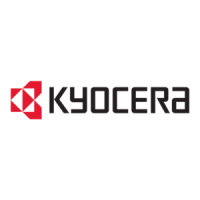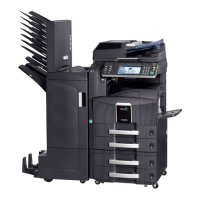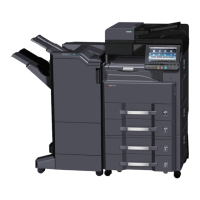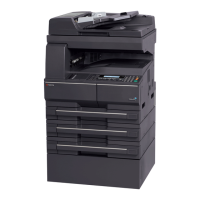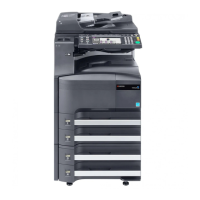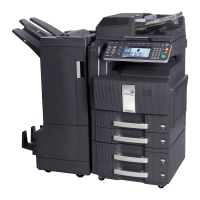Do you have a question about the Kyocera TASKalfa 4550ci and is the answer not in the manual?
Identifies keys and displays on the machine's control panel.
Identifies the main components and external parts of the machine.
Verifies all included accessories and documents are present.
Guides on selecting and preparing cables for PC or network connection.
Provides step-by-step instructions for connecting LAN and USB cables.
Explains the procedure for turning the machine's main power on and off.
Details energy-saving modes to reduce power consumption.
Explains sleep modes for power saving when the machine is idle.
Procedure to change the touch panel display language.
Procedure to set the machine's local date and time.
Guides on configuring network settings for LAN connections.
Instructions for installing necessary drivers and utilities from the DVD.
Explains how to load paper into various trays and feeders.
Provides instructions for placing originals on the platen or in the document processor.
Explains how to log in and out of the machine for user authentication.
Explains the use of Enter and Quick No. Search keys on the operation panel.
Describes the touch panel display and key states.
How to display a preview image of scanned documents before copying.
How to select the color mode for scanning originals.
Details the basic steps for making copies of documents.
Outlines the procedures for sending scanned documents via network or USB.
Explains how to store and retrieve documents using custom and job boxes.
Describes how to cancel print or send jobs currently in progress.
How to specify the size of the original document for copying.
How to select the correct paper source and size for copying.
Procedures for copying originals of different sizes simultaneously.
Instructions for creating booklet-style copies by folding.
How to apply Bates stamps to copied documents.
Enables scanning originals in batches for large jobs.
Step-by-step guide for printing documents from PC applications.
Explains how to store and print jobs using the machine's job box feature.
How to select the size of the original for scanning and sending.
Options for selecting the file format (PDF, TIFF, JPEG, XPS) for sending.
How to set the subject and body for scanned documents sent via email.
Procedure for scanning documents using the Web Services for Devices protocol.
Instructions for scanning documents using a TWAIN-compliant application.
Creating, managing, and using custom document storage boxes.
How to save scanned documents directly to USB memory.
How to view the status of printing, sending, and storing jobs.
Procedures for canceling or pausing active print or send jobs.
How to check toner levels, paper status, and waste toner box.
Checking the status and configuring connected devices and network interfaces.
Basic machine settings including language, sound, and screen defaults.
Setting default options for copying functions.
Setting default options for sending functions.
Configuring default settings related to printer operations.
Procedures for adjusting print quality and performing machine maintenance.
Configuring network settings such as TCP/IP and host name.
How to enable and configure user authentication for machine access.
Setting up and managing job accounting for tracking usage.
Procedures for routine maintenance, including toner replacement.
Instructions for cleaning various parts of the machine to maintain quality.
General guidelines and checkpoints for resolving common machine issues.
How to interpret and address error messages displayed on the touch panel.
Step-by-step instructions for removing jammed paper from various locations.
Overview of available optional hardware components for the machine.
Guide on using the on-screen keyboard for text input.
Details on supported paper types, sizes, and specifications.
Technical specifications of the machine and its components.
Definitions of technical terms used in the manual.
Identifies keys and displays on the machine's control panel.
Identifies the main components and external parts of the machine.
Verifies all included accessories and documents are present.
Guides on selecting and preparing cables for PC or network connection.
Provides step-by-step instructions for connecting LAN and USB cables.
Explains the procedure for turning the machine's main power on and off.
Details energy-saving modes to reduce power consumption.
Explains sleep modes for power saving when the machine is idle.
Procedure to change the touch panel display language.
Procedure to set the machine's local date and time.
Guides on configuring network settings for LAN connections.
Instructions for installing necessary drivers and utilities from the DVD.
Explains how to load paper into various trays and feeders.
Provides instructions for placing originals on the platen or in the document processor.
Explains how to log in and out of the machine for user authentication.
Explains the use of Enter and Quick No. Search keys on the operation panel.
Describes the touch panel display and key states.
How to display a preview image of scanned documents before copying.
How to select the color mode for scanning originals.
Details the basic steps for making copies of documents.
Outlines the procedures for sending scanned documents via network or USB.
Explains how to store and retrieve documents using custom and job boxes.
Describes how to cancel print or send jobs currently in progress.
How to specify the size of the original document for copying.
How to select the correct paper source and size for copying.
Procedures for copying originals of different sizes simultaneously.
Instructions for creating booklet-style copies by folding.
How to apply Bates stamps to copied documents.
Enables scanning originals in batches for large jobs.
Step-by-step guide for printing documents from PC applications.
Explains how to store and print jobs using the machine's job box feature.
How to select the size of the original for scanning and sending.
Options for selecting the file format (PDF, TIFF, JPEG, XPS) for sending.
How to set the subject and body for scanned documents sent via email.
Procedure for scanning documents using the Web Services for Devices protocol.
Instructions for scanning documents using a TWAIN-compliant application.
Creating, managing, and using custom document storage boxes.
How to save scanned documents directly to USB memory.
How to view the status of printing, sending, and storing jobs.
Procedures for canceling or pausing active print or send jobs.
How to check toner levels, paper status, and waste toner box.
Checking the status and configuring connected devices and network interfaces.
Basic machine settings including language, sound, and screen defaults.
Setting default options for copying functions.
Setting default options for sending functions.
Configuring default settings related to printer operations.
Procedures for adjusting print quality and performing machine maintenance.
Configuring network settings such as TCP/IP and host name.
How to enable and configure user authentication for machine access.
Setting up and managing job accounting for tracking usage.
Procedures for routine maintenance, including toner replacement.
Instructions for cleaning various parts of the machine to maintain quality.
General guidelines and checkpoints for resolving common machine issues.
How to interpret and address error messages displayed on the touch panel.
Step-by-step instructions for removing jammed paper from various locations.
Overview of available optional hardware components for the machine.
Guide on using the on-screen keyboard for text input.
Details on supported paper types, sizes, and specifications.
Technical specifications of the machine and its components.
Definitions of technical terms used in the manual.
| Network ready | Yes |
|---|---|
| Fax compatibility | ITU-T G3 |
| Dimensions (WxDxH) | 668 x 767 x 747 mm |
| All-in-one functions | Copy, Fax, Print, Scan |
| Connectivity technology | Wired |
| Color all-in-one functions | copy, fax, print, scan |
| DVD/CD printing | No |
| Print technology | Laser |
| Maximum resolution | 600 x 600 DPI |
| Duplex printing mode | Auto |
| Time to first page (black, normal) | 4.7 s |
| Time to first page (color, normal) | 6.2 s |
| Print speed (black, normal quality, A3) | 22 ppm |
| Print speed (black, normal quality, A4/US Letter) | 45 ppm |
| Printing colors | Black, Cyan, Magenta, Yellow |
| Maximum duty cycle | - pages per month |
| Number of print cartridges | 4 |
| Page description languages | Microsoft XPS, PCL 5c, PCL 6, PCL XL, PostScript 3 |
| Copier resize | 25 - 400 % |
| Maximum number of copies | 999 copies |
| N-in-1 copy function (N=) | 2, 4 |
| Scan to | E-mail, FTP, OCR, USB |
| Grayscale levels | 256 |
| Maximum scan area | A3 (297 x 420) mm |
| Scan speed (black) | 140 ppm |
| Scan speed (color) | 110 ppm |
| Image formats supported | JPG, TIF |
| Fax memory | 120 MB |
| Modem speed | 33.6 Kbit/s |
| Fax coding methods | JBIG, MH, MMR (Fax coding method), MR |
| Fax transmission speed | 3 sec/page |
| Paper input type | Paper tray |
| Total input capacity | 1150 sheets |
| Total output capacity | 250 sheets |
| Maximum input capacity | 7650 sheets |
| Total number of input trays | 3 |
| Multi-Purpose tray input capacity | 150 sheets |
| Maximum print size | 297 x 420 mm |
| Duplex media weight | 60 - 256 g/m² |
| Paper tray media types | Plain paper |
| Paper tray media weight | 60 - 220 g/m² |
| ISO A-series sizes (A0...A9) | A3, A4 |
| Maximum ISO A-series paper size | A3 |
| Multi-Purpose Tray media weight | 60 - 300 g/m² |
| Display | LCD |
| Market positioning | Business |
| Standard interfaces | Ethernet, USB 2.0 |
| USB 2.0 ports quantity | 2 |
| Processor model | 750GL |
| Processor family | PowerPC |
| Compatible memory cards | CF |
| Internal storage capacity | 320 GB |
| Sound power level (standby) | 58 dB |
| Sound pressure level (printing) | 72.5 dB |
| AC input voltage | 100 - 240 V |
| AC input frequency | 50 - 60 Hz |
| Power consumption (standby) | 200 W |
| Power consumption (PowerSave) | 21 W |
| Power consumption (average operating) | 1070 W |
| Sustainability certificates | ENERGY STAR |
| Certification | GS, TÜV, CE, RoHS |
